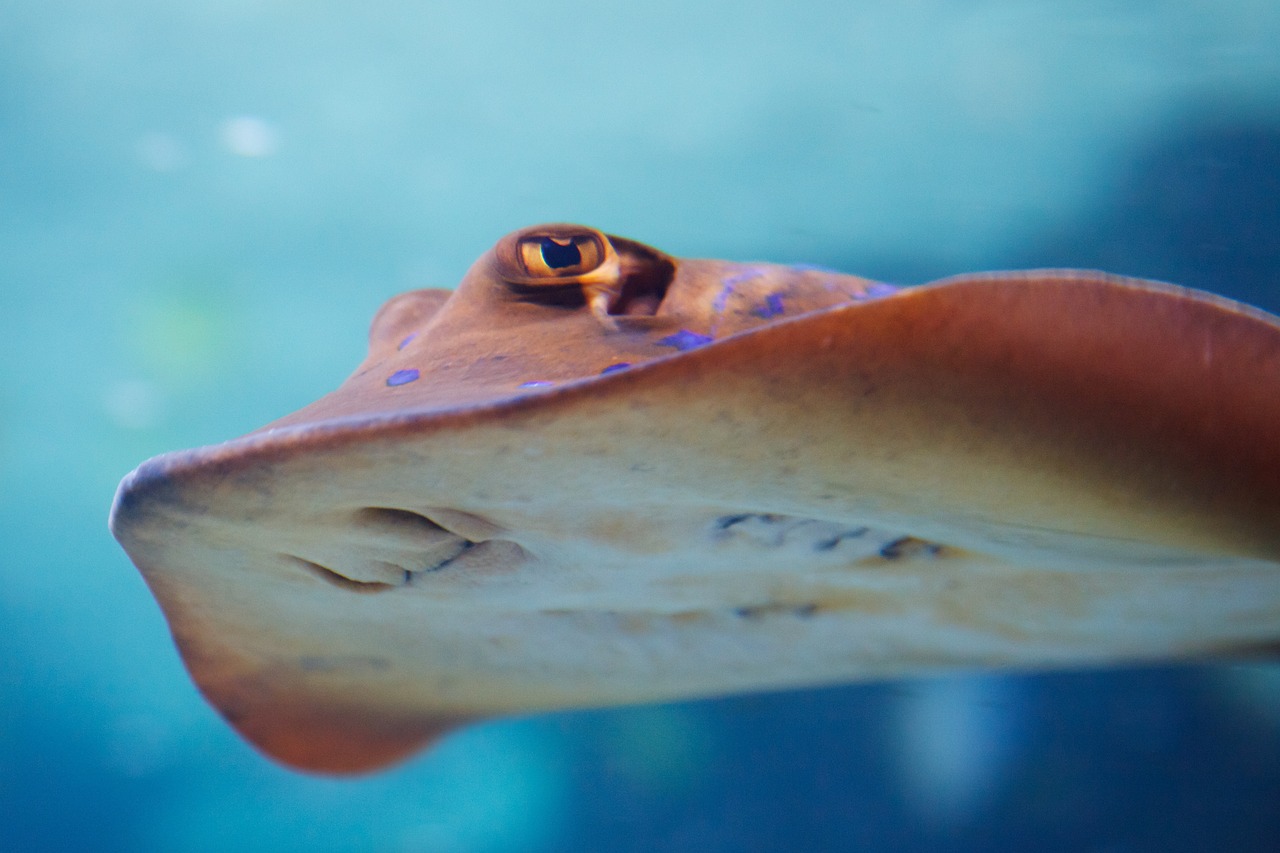Table of Contents
![]()
Stingrays, with their graceful movements and captivating appearances, have become increasingly popular as exotic pets. However, maintaining a healthy and thriving stingray aquarium comes with its own set of unique challenges. Understanding these challenges is crucial for ensuring the well-being of these fascinating creatures and for creating a thriving aquatic environment. This article explores the various difficulties associated with keeping a stingray aquarium, providing insights into tank setup, stingray care, and other critical factors.
Tank Setup and Maintenance
Size and Design Requirements
One of the most fundamental aspects of keeping stingrays is providing an adequately sized tank. Stingrays require a large, spacious environment to thrive. The minimum tank size varies depending on the species, but generally, a tank should be at least 180 gallons for smaller species and up to 300 gallons or more for larger species. The size of the tank impacts the health and behavior of stingrays, as they need ample room to swim and explore.
The shape of the tank is also crucial. Stingrays prefer long, low tanks that provide ample floor space rather than height. A tank with a low profile allows stingrays to exhibit natural behaviors and prevents them from becoming stressed or injured.
Substrate Selection
Choosing the right substrate is another essential aspect of tank setup. Stingrays are bottom-dwellers, so the substrate plays a significant role in their comfort and health. Fine sand is typically the best option, as it mimics their natural habitat and reduces the risk of injury. Gravel or coarse substrates can cause damage to stingrays’ delicate undersides and should be avoided.
Maintaining the substrate is also important. Regular cleaning is necessary to prevent the buildup of waste and detritus, which can affect water quality. However, care must be taken during cleaning to avoid disturbing the stingrays or causing stress.
Filtration and Water Quality
Stingrays have high filtration requirements due to their large size and the significant amount of waste they produce. A powerful filtration system is essential to maintain clean and healthy water conditions. Canister filters or sump systems are commonly used to provide adequate water flow and filtration.
Maintaining water quality involves monitoring several key parameters, including salinity, pH, and temperature. Stingrays are sensitive to changes in these conditions, so regular testing and adjustments are necessary to keep the water stable. Water quality issues can lead to stress and health problems for stingrays.
Stingray Health and Nutrition
Dietary Needs
Feeding stingrays requires careful attention to their dietary needs. Stingrays are primarily carnivorous and require a diet that includes a variety of food sources such as live or frozen foods, including shrimp, fish, and worms. High-quality commercial pellets can also be a part of their diet.
The frequency and quantity of feeding depend on the species and size of the stingrays. Generally, feeding should occur two to three times a week, with portions adjusted to avoid overfeeding or underfeeding. Proper nutrition is crucial for their health, growth, and overall well-being.
Health Monitoring
Monitoring the health of stingrays involves being vigilant for signs of stress or illness. Common health issues include parasitic infections, bacterial infections, and injuries. Observing behavior, such as changes in activity levels or feeding habits, can help identify potential health problems early.
Treatment of health issues requires prompt attention and may involve medications or changes in water quality. Preventative measures, such as maintaining optimal tank conditions and providing a balanced diet, are essential for reducing the risk of health problems.
Behavioral and Social Needs
Stingrays have specific behavioral and social needs that must be addressed. When selecting tank mates, it is important to choose species that are compatible with stingrays. Aggressive or incompatible species can cause stress or harm.
Providing environmental enrichment is also important for stimulating natural behaviors. This can include adding structures or hiding spots in the tank to create a more dynamic and engaging environment for the stingrays.
Challenges Specific to Stingray Care
Stingray Handling and Safety
Handling stingrays requires careful techniques to avoid causing stress or injury. Stingrays have venomous barbs on their tails that can deliver a painful sting. Proper handling techniques involve supporting the stingray gently and minimizing direct contact with the tail.
Safety is a key consideration for both the stingrays and the aquarium keepers. It is important to educate oneself about the potential risks and to use appropriate precautions when interacting with stingrays.
Legal and Ethical Considerations
Keeping stingrays as pets involves understanding and complying with local regulations and permits. Some regions have specific laws governing the ownership of exotic animals, including stingrays. It is essential to be aware of these regulations to ensure legal and responsible ownership.
Ethical considerations also play a role in stingray care. Captivity can impact wild populations, so supporting sustainable practices and avoiding illegal or unethical sources for acquiring stingrays is important for conservation efforts.
Cost and Financial Considerations
Initial Setup Costs
Setting up a stingray aquarium involves significant initial costs. This includes the purchase of a large tank, high-quality filtration equipment, substrate, and other necessary supplies. Additionally, the cost of acquiring stingrays can vary depending on the species and source.
Ongoing Maintenance Costs
Ongoing costs include expenses for food, water treatments, and maintenance supplies. Regular replacement of filter media and other equipment parts is also necessary to ensure the proper functioning of the tank.
Potential Veterinary Expenses
Veterinary care for stingrays can be specialized and potentially costly. Routine check-ups and emergency care may require visits to veterinarians with experience in aquatic animals. Being prepared for potential veterinary expenses is an important aspect of responsible stingray ownership.
Conclusion
Keeping a stingray aquarium presents a range of challenges that require careful planning and attention. From setting up and maintaining the tank to addressing the specific needs of stingrays, successful care involves a commitment to understanding and meeting these needs. By addressing each challenge thoughtfully and proactively, aquarium enthusiasts can enjoy the unique experience of keeping stingrays while ensuring their health and well-being. For those considering this rewarding endeavor, thorough research and preparation are key to creating a thriving and enjoyable stingray habitat.
Share This





Be the first to comment